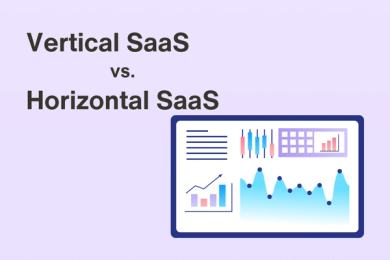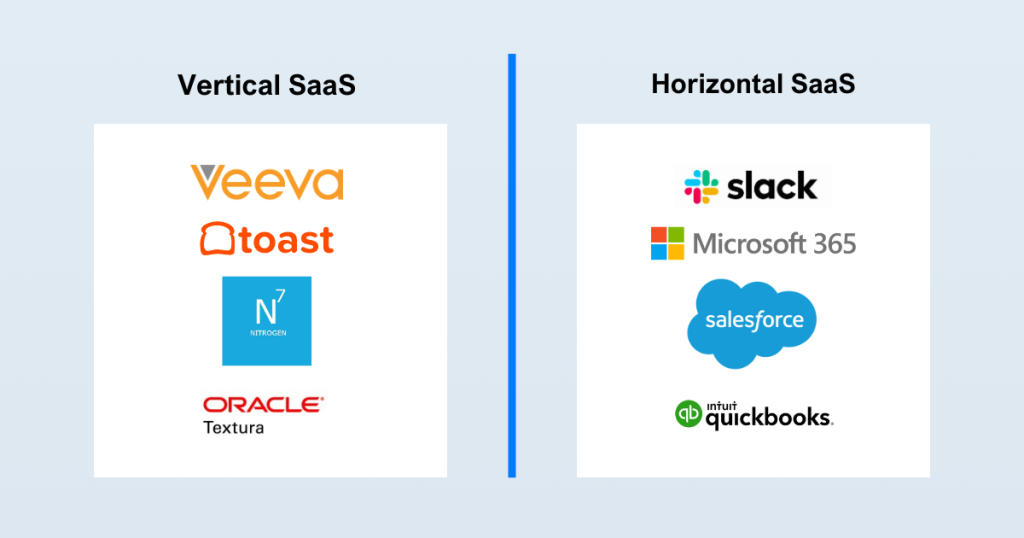Vertical SaaS vs. Horizontal SaaS
Updated May 30, 2024
Published July 16, 2023

The SaaS (Software as a Service) industry relies on two main business models: vertical SaaS and horizontal SaaS. Whether you are looking to leverage SaaS solutions or potentially run a SaaS company, understanding the distinctions between these models is key.
Vertical SaaS providers cater their software to a specific industry or niche, like insurance or restaurants. Horizontal SaaS serves a wider range of sectors with versatile tools for cross-industry needs like CRM and HR.
In this article, we will highlight the defining differences between vertical and horizontal SaaS approaches.
Let’s dive in!
What is Vertical SaaS?
Vertical SaaS companies make software for one specific industry or niche. They don’t try to make software for many different industries like horizontal SaaS does. Vertical SaaS picks one type of business to specialize in. That niche could be anything – healthcare, real estate, finance, manufacturing, etc.
Often vertical SaaS targets small niches that don’t have big software options yet. The company may see the need for industry-specific software that giant software companies aren’t providing.
Since they only work in one niche, vertical SaaS companies can really deepen their expertise in that industry’s needs. They get to know the specific problems and workflows that the niche faces.
This knowledge helps vertical SaaS companies build software tailored to their industry. The programs solve issues and fit workflows that are unique to that vertical. The software ends up being highly customized.
Some well-known examples of vertical-SaaS companies include:
- Veeva offers cloud-based software for the life sciences industry, including pharmaceutical, biotech, and medical device companies.
- Nitrogen offers portfolio analysis and risk assessment software specifically for financial advisors.
- Toast provides specialized point-of-sale and restaurant management tools tailored for food service businesses.
In summary, vertical SaaS goes deep, not wide. By focusing on one niche, they offer specialized solutions, not general software, for many industries. Their target is in-depth, custom-fit tools for a particular type of business.

What is Horizontal SaaS?
Horizontal SaaS companies offer software solutions that work across many different industries. Unlike vertical SaaS, they serve a wide range of business sectors.
The tools from horizontal SaaS focus on capabilities that most companies need, regardless of their industry. These include functions like customer relationship management, human resource management, accounting, and project management.
For example, a horizontal SaaS firm may provide customer relationship management tools flexible enough for manufacturing, healthcare, financial services, and other industries to use.
Since they serve many sectors, horizontal SaaS solutions aim to be versatile for diverse businesses instead of being specialized. The software can be utilized by various companies rather than customized for any single industry.
Here are some examples of major horizontal SaaS companies:
- Microsoft Office 365 provides productivity and collaboration tools used by all types of organizations.
- Salesforce offers customer relationship management software to many sectors.
- Intuit QuickBooks provides accounting and financial management tools flexible for diverse businesses.
- Slack offers team communication and collaboration software to all types of businesses.
In summary, horizontal SaaS provides multi-purpose software applicable across verticals. Their broad focus allows scaling but less customization.
Differences Between Vertical SaaS and Horizontal SaaS
Now that we’ve established what are vertical saas and horizontal saas, we can highlight some of the key differences between them. By comparing them, we can better understand their respective pros and cons and which is better for specific software needs. Here is a quick summary:
| Vertical SaaS | Horizontal SaaS |
|---|---|
| Single niche industry | Multiple industries |
| Highly customized for niche | Broadly applicable across sectors |
| Deep knowledge of niche | General knowledge across industries |
| Competition within niche | Higher competition across broad market |
| Harder to expand beyond the niche | Easy to expand across industries |
| Specialized end-to-end solutions for niche | Versatile and adjustable platforms |
| Reliant on a single industry | Diversified across industries |
| Premium pricing enabled by customization | Usually standardized pricing tiers |
| Targeted, focused marketing strategy | Aggressive, broad promotion |
Market Reach
Horizontal SaaS companies serve many industries, so their potential customer base is much larger compared to vertical SaaS. A wider audience provides greater opportunities for revenue, scaling, and rapid user growth. However, it also means more competitors fighting for market share.
Meanwhile, vertical SaaS deliberately limits its reach to one niche industry. This shrinks their total addressable market but enables the vertical vendor to be a “big fish in a small pond” and more easily establish domain authority in their specialty.
Specialized Functionality
A key advantage of vertical SaaS is providing features tailored to the specific industry. For example, construction software can incorporate specialized workflows like submittals and change orders. This optimization for industry requirements is difficult for horizontal SaaS covering many sectors.
Horizontal SaaS focuses on capabilities useful to organizations universally, like CRM and project management. While multi-purpose, these lack native optimizations that vertical SaaS can purpose-build for niche workflows.
Industry Expertise
Vertical SaaS cultivates expertise by completely focusing on one sector. This allows a nuanced understanding of concepts like industry lingo, regulations, workflows, and pain points. Horizontal SaaS, serving many areas, gains less domain knowledge in each.
For instance, fintech SaaS intimately understands concepts like KYC and AML requirements that horizontal SaaS may grasp only vaguely. This depth of expertise lets vertical SaaS anticipate niche needs better.
Business Models
Vertical SaaS solutions are designed end-to-end around an industry’s specialized requirements. This means form-fitting the software ergonomics to match how the niche intuitively works.
Horizontal SaaS utilizes a more general-purpose approach adjustable for multiple sectors. While versatile, this inherently lacks the tailored fit of vertical solutions built just for a niche.
Competition Level
With a smaller niche target market, vertical SaaS startups face less competition, especially if serving an emerging vertical. Established horizontal vendors compete extensively across all sectors.
This enables vertical SaaS to more easily win market share by becoming a category leader in a tightly defined space. Horizontal solutions have to differentiate themselves across a wide field of competitors.
Scalability
Horizontal SaaS is engineered to scale across diverse markets with minimal incremental effort. Once the platform is built, expanding to new sectors is straightforward.
Meanwhile, vertical SaaS products require significant rework to move into new industries. The optimized niche features don’t transplant easily outside the core vertical without customization.
Industry Dependence
Vertical SaaS depends wholly on the fortunes and cycles of one industry. Downturns and fluctuations have an outsized impact. Horizontal SaaS mitigates risk through diversification across sectors. If one industry declines, others may remain strong.
For example, an economic recession could simultaneously hurt law firms utilizing legal software while benefiting discount retailers that sell to thrifty consumers.
Pricing Models
Vertical SaaS products often utilize premium pricing models compared to horizontal SaaS due to the higher costs required for extensive customization. Some examples:
- Vertical SaaS may charge per user like horizontal SaaS, but at a higher price point, given the niche customization.
- Usage-based pricing is common, charging based on how much clients use vertical SaaS customized for their needs.
- Value-based pricing allows vertical SaaS to charge premiums proportional to the niche value they provide.
- Many verticals use commissioned pricing, taking a % of transactions enabled by their software.
- Custom modeling is common in vertical SaaS, with prices tailored to each client’s particular integration needs.
Overall vertical SaaS companies use premium pricing enabled by customization. Horizontal SaaS companies follow more standardized pricing tiers due to offering a generalized platform.
Marketing Strategies
For any SaaS firm, marketing is a major investment, especially early on. In fact, the average SaaS company spends 118% of its revenue on sales and marketing in its first five years. Both vertical and horizontal SaaS businesses must be strategic in allocating resources to maximize the return on their marketing efforts and efficiently acquire customers.
Vertical SaaS companies take a targeted approach to marketing, focused on their niche audience rather than a broad strategy. Common vertical SaaS marketing tactics include:
- Paid advertising in industry publications and websites to reach their precise audience
- Attending industry trade shows and events to connect with potential customers
- Developing referral programs to leverage their existing customer base
- Creating thought leadership content tailored to their niche
- Forming partnerships with industry players to expand their reach and provide comprehensive solutions
In contrast, horizontal SaaS companies market their platforms across many channels to diverse audiences. Their strategies aim for broad visibility and mass appeal.
In short, vertical SaaS businesses pursue a conservative, laser-focused strategy, while horizontal SaaS businesses require aggressive, broad promotion. The marketing approach aligns with their respective target markets.
Hybrid Approaches
Rather than pure vertical or horizontal models, many SaaS companies take hybrid approaches:
Separate Products
Some vendors offer distinct horizontal and vertical products. For example, Veeva has a general Vault platform plus tailored Vault editions for life sciences, and chemicals verticals. This combines broad and niche capabilities.
Augmenting Platforms
Other vendors start with a horizontal platform and then augment it for vertical needs via add-ons, templates, and configurability. Salesforce enables this by providing industry editions of its CRM for financial services, healthcare, media, and more.
Incorporating Data Models
Vendors may also leverage common horizontal systems but incorporate vertical data models. For instance, enterprise resource planning (ERP) software could use specialized objects for insurance claims, real estate listings, and student enrollments.
Flexible Configurability
Leading SaaS products aim to balance consistency across customers with configurability for niches. Platforms like ServiceNow enable tailoring workflows, data models, and interfaces for industry requirements while maintaining cross-industry foundations.
In summary, blending both vertical and horizontal capabilities allows SaaS vendors to provide specialized customization while optimizing scalability. Hybrid approaches give customers the flexibility to adapt platforms to their unique needs.
Final Thoughts
The choice between vertical and horizontal SaaS depends on specific needs. Large enterprises often benefit from combining both. Smaller businesses should be cautious about over-customizing with vertical SaaS initially.
We’ll likely see continued fragmentation of horizontal vendors into specialized verticals. But vertical SaaS companies will also expand across adjacent segments, blurring lines.
Neither model is inherently superior. But vertical SaaS thrives where customization provides an edge. Their rise reflects the demand for specialization.
Ultimately, customers win when vertical and horizontal SaaS compete. The friction between them drives innovation. Both models play vital complementary roles.
Frequently Asked Questions
Share This Post
Della Yang
Della Yang is a marketing professional with a passion for the ever-changing digital landscape. She frequently writes tech news and reviews, sharing her knowledge and insights through blogs and various online platforms.
Allow cookies
This website uses cookies to enhance the user experience and for essential analytics purposes. By continuing to use the site, you agree to our use of cookies.
